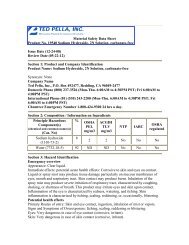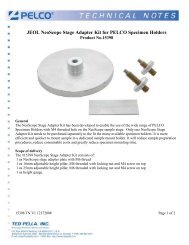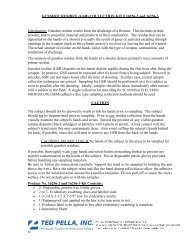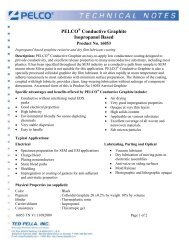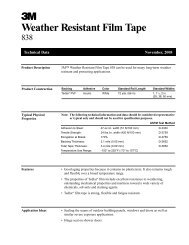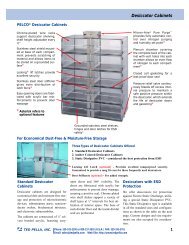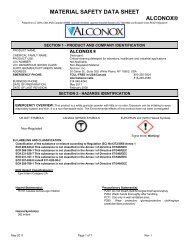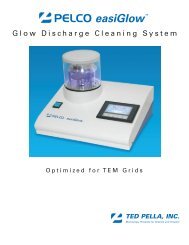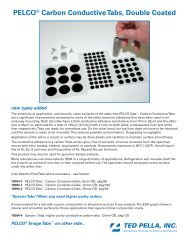MSDS - Ted Pella, Inc.
MSDS - Ted Pella, Inc.
MSDS - Ted Pella, Inc.
You also want an ePaper? Increase the reach of your titles
YUMPU automatically turns print PDFs into web optimized ePapers that Google loves.
Material Safety Data Sheet<br />
Product No. 19920 PELCO® Pro Cyanoacrylate Debonder<br />
Issue Date (10-02-03)<br />
Review Date (06-01-12)<br />
Section 1: Product and Company Identification<br />
Product Name: PELCO® Pro Cyanoacrylate Debonder<br />
Synonym: None<br />
Company Name<br />
<strong>Ted</strong> <strong>Pella</strong>, <strong>Inc</strong>., P.O. Box 492477, Redding, CA 96049-2477<br />
Domestic Phone (800) 237-3526 (Mon-Thu. 6:00AM to 4:30PM PST; Fri 6:00AM to<br />
4:00PM PST)<br />
International Phone (01) (530) 243-2200 (Mon-Thu. 6:00AM to 4:30PM PST; Fri<br />
6:00AM to 4:00PM PST)<br />
Chemtrec Emergency Number 1-800-424-9300 24 hrs a day.<br />
Section 2: Composition / Information on Ingredients<br />
Principle Hazardous %<br />
OSHA ACGIH<br />
Component(s)<br />
PEL TLV<br />
(chemical and common name(s))<br />
(Cas. No)<br />
mg/m3 mg/m3<br />
NTP<br />
IARC<br />
OSHA<br />
regulated<br />
Nitromethane (75-52-5) >80 250 50 No * 2B Yes<br />
* Some evidence of carcinogenicity was noted in NTP tests. The effects were mammary<br />
tumors in female rats and benign haderian gland tumors in mice.<br />
Section 3: Hazard Identification<br />
Emergency overview<br />
Appearance: Clear Liquid.<br />
Immediate effects: Onset of symptoms from any route of exposure may be delayed.<br />
Potential health effects<br />
Primary Routes of entry: Skin, inhalation, ingestion<br />
Signs and Symptoms of Overexposure: Liquid-Prolong exposure can lead to mild<br />
irritation due to de-fatting.<br />
Eyes: May cause irritation and corneal damage.<br />
Skin: May cause irritation, redness, and pain. May be absorbed through skin with<br />
symptoms similar to those from inhalation.<br />
Ingestion: Only slightly Toxic by ingestion.<br />
Inhalation: Vapors may cause irritation to respiratory tract. A weak narcotic, higher<br />
concentrations may cause nausea, vomiting, diarrhea, and headaches.<br />
Chronic Exposure: Repeated or prolonged skin exposure may cause dermatitis. Prolonged<br />
inhalation of vapors may cause liver damage.<br />
Chemical Listed As Carcinogen Or Potential Carcinogen: Nitromethane (75-52-5)
See Toxicological Information (Section11)<br />
Potential environmental effects<br />
See Ecological Information (Section 12)<br />
Section 4: First Aid Measures<br />
If accidental overexposure is suspected<br />
Eye(s) Contact: Immediately flush eyes with plenty of water for at least 15 minutes,<br />
lifting lower and upper eyelids occasionally. Get medical attention immediately.<br />
Skin Contact: Immediately flush skin with plenty of soap and water for at least 15<br />
minutes while removing contaminated clothing and shoes. Wash clothing before reuse.<br />
Thoroughly clean shoes before reuse. Get medical attention.<br />
Inhalation: Remove to fresh air. Call a physician, who may check for increased<br />
methemoglobin content.<br />
Ingestion: Induce vomiting by giving victim 2 glasses of water and having him place a<br />
finger down the throat. Never give anything by mouth to an unconscious person.<br />
Note to physician<br />
Treatment: NIF<br />
Medical Conditions generally Aggravated by Exposure: Persons with pre-existing skin<br />
disorders, or impaired liver, or pulmonary function may be more susceptible to the effects<br />
of this substance.<br />
Section 5: Fire Fighting Measures<br />
Flash Point: 96 ºF. 35 ºC (method used C.O.C.)<br />
Flammable Limits: LEL = 7.3% UEL = N/A<br />
Auto-ignition point: 418 ºC (784 ºF) for nitromethane<br />
Fire Extinguishing Media: Carbon Dioxide, dry chemicals, water.<br />
Special Fire Fighting Procedures: Wet down tank and containers to prevent pressure and<br />
heat build-up.<br />
Unusual Fire and Explosion Hazards: Sensitized by amines, alkalis, acids: can detonate<br />
by adiabatic compression. Dry alkali or amine salts are explosives.<br />
Hazardous combustion products: Burning may produce carbon monoxide, carbon<br />
dioxide, nitrogen oxides.<br />
DOT Class: Flammable liquid.<br />
Section 6: Accidental Release Measures<br />
Steps to be Taken in Case Material is Released or Spilled: Evacuate area and remove<br />
potential sources of spark or flame. Properly protected personnel may then attempt to<br />
contain large spills and pump to salvage. Absorb unrecoverable spills with an inert solid<br />
such as sand or earth. Flush area with water.<br />
Waste Disposal Methods: Dispose of waste according to Federal, State and Local<br />
Regulations.<br />
Section 7: Handling and Storage<br />
Precautions to be Taken in Handling and Storage: Keep away from heat and flame.<br />
Protect from high energy impacts. Keep away from children. Shelf Life: Twelve months<br />
in original sealed container.
Storage temperature: Store in a cool, dry well-ventilated location.<br />
Storage Pressure: NA<br />
Section 8: Exposure Controls / Personal Protection<br />
Engineering Controls<br />
Ventilation required: Use chemical fume hood. General ventilation with local exhaust in<br />
areas of high vapor concentrations.<br />
Personal Protection Equipment<br />
Respiratory protection: Air supplied respiration or self-contained breathing apparatus in<br />
area of high vapor concentration. Do not use canister type face mask because break<br />
through is not easily detected.<br />
Protective gloves: Rubber Gloves.<br />
Skin protection: Rubber Apron.<br />
Eye protection: Safety Glasses.<br />
Additional clothing and/or equipment: NIF<br />
Exposure Guidelines<br />
See Composition/Information on Ingredients (Section2)<br />
Section 9 Physical and Chemical Properties<br />
Appearance and Physical State: Clear liquid.<br />
Odor (threshold): Mild characteristic odor.<br />
Specific Gravity (H2O=1): 1.124. 1.229<br />
Vapor Pressure (mm Hg): 27.3 (mm Hg @ 68ºF or 20ºC)<br />
Vapor Density (air=1): 2.1<br />
Percent Volatile by volume: 100%<br />
Evaporation Rate (butyl acetate=1): 100-139<br />
Boiling Point: 213ºF - 101ºC<br />
Freezing point / melting point: ND<br />
pH: NA<br />
Solubility in Water: 10.5 % by weight @ 68F 0r 20ºC<br />
Molecular Weight: ND<br />
Section 10: Stability and Reactivity<br />
Stability: Stable.<br />
Conditions to Avoid: Shock under heavy confinement. Adiabatic compression.<br />
Sensitization: Do not trap between closed valves or use positive displacement pumps to<br />
discharge nitromethane.<br />
Materials to Avoid (<strong>Inc</strong>ompatibility): Lead, copper, their alloys-amines, strong alkalis,<br />
strong acids.<br />
Hazardous Decomposition Products: ND<br />
Hazardous Polymerization: Will not occur.<br />
Section 11: Toxicological Information<br />
Results of component toxicity test performed: Nitromethane (75-52-5): Oral rat LD50:<br />
940 mg/kg
Human experience: ND<br />
This product does contain compounds listed by NTP or IARC or regulated by OSHA as a<br />
carcinogen. Nitromethane (75-52-5)<br />
Section 12: Ecological Information<br />
Ecological Information: Nitromethane (75-52-5): When released into the soil, this<br />
material may leach into groundwater. When released into the soil, this material is<br />
expected to quickly evaporate. When released into water, this material is not expected to<br />
biodegrade. When released into water, this material may evaporate to a moderate extent.<br />
When released into water, this material is expected to have a half-life between 10 and 30<br />
days. This material has an experimentally-determined bioconcentration factor (BCF) of<br />
less than 100. This material has a log octanol-water partition coefficient of less than 3.0.<br />
This material is not expected to significantly bioaccumulate. When released into the air,<br />
this material is expected to be readily degraded by photolysis. When released into the air,<br />
this material is expected to have a half-life of less than 1 day.<br />
Chemical Fate Information: ND<br />
Section 13 Disposal Considerations<br />
RCRA 40 CFR 261 Classification: For the purposes of disposal, Nitromethane is<br />
classified by EPA as a hazardous waste. Undiluted material is EPA Hazardous Waste<br />
Number D001 characteristic of ignitability.<br />
Federal, State and local laws governing disposal of materials can differ. Ensure proper<br />
disposal compliance with proper authorities before disposal.<br />
Section 14: Transportation Information<br />
US DOT Information: Proper shipping name: Nitromethane<br />
Hazard Class: 3<br />
Packaging group: II<br />
UN Number: UN 1261<br />
IATA: Proper shipping name: Nitromethane<br />
Hazard Class: 3<br />
Packing group: II<br />
UN Number: UN1261<br />
Limitations: Air Cargo Only<br />
IMO: Proper shipping name: Nitromethane<br />
Class: 3<br />
UN Number: UN1261<br />
Packing group: II<br />
Marine Pollutant: No<br />
Canadian TDG: Proper shipping name: Nitromethane<br />
Section 15: Regulatory Information<br />
United States Federal Regulations<br />
<strong>MSDS</strong> complies with OSHA’s Hazard Communication Rule 29, CFR 1910.1200.<br />
SARA: 311/312: Acute: Yes. Chronic: Yes. Fire: Yes. Pressure: No. Reactivity: Yes<br />
(Pure / Liquid)
SARA Title III: 302/304: None. 313: None<br />
RCRA: No<br />
TSCA: 8(d): No<br />
CERCLA: No<br />
State Regulations<br />
California Proposition 65: Nitromethane (75-52-5) is known by the state of California to<br />
cause cancer<br />
International Regulations<br />
Canada WHMIS: This <strong>MSDS</strong> has been prepared according to the hazard criteria of the<br />
Controlled Products Regulations (CPR) and the <strong>MSDS</strong> contains all of the information<br />
required by the CPR.<br />
Europe EINECS Numbers: ND<br />
Section 16: Other Information<br />
Label Information: Keep away from heat, sparks and flame. Keep container closed. Use<br />
only with adequate ventilation. Wash thoroughly after handling. Avoid contact with eyes,<br />
skin and clothing. Avoid breathing vapor.<br />
European Risk and Safety Phrases: ND<br />
European symbols needed: ND<br />
Canadian WHMIS Symbols: ND<br />
HMIS Hazard Rating: Health: 1; Flammability: 3; Reactivity: 3<br />
(0=least, 1=Slight, 2=Moderate, 3=High, 4=Extreme)<br />
Abbreviations used in this document<br />
NE= Not established<br />
NA= Not applicable<br />
NIF= No Information Found<br />
ND= No Data<br />
Disclaimer<br />
<strong>Ted</strong> <strong>Pella</strong>, <strong>Inc</strong>. makes no warranty of any kind regarding the information furnished<br />
herein. Users should independently determine the suitability and completeness of<br />
information from all sources. While this data is presented in good faith and believed to be<br />
accurate, it should be considered only as a supplement to other information gathered by<br />
the user. It is the User's responsibility to assure the proper use and disposal of these<br />
materials as well as the safety and health of all personnel who may work with or<br />
otherwise come in contact with these materials.<br />
<strong>MSDS</strong> Form 0013F1 V2



